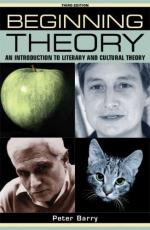
|
| Name: _________________________ | Period: ___________________ |
This test consists of 15 multiple choice questions and 5 short answer questions.
Multiple Choice Questions
1. The chapter "Feminist Criticism" suggests that feminist criticism became much more ________, meaning that it began to draw upon the findings and approaches of other kinds of criticism.
(a) Trope.
(b) Eclectic.
(c) Perlocutionary.
(d) Rhetoric.
2. The narrator states that the study of English literature was seen as a kind of substitute for ________.
(a) History.
(b) Science.
(c) Social studies.
(d) Religion.
3. The Introduction states that another name for traditional literary criticism is ________.
(a) Independant humanism.
(b) Conservative humanism.
(c) Liberal humanism.
(d) Modern humanism.
4. According to the chapter titled Theory Before Theory--Liberal Humanism, structuralism and post-structuralism originated in what country?
(a) Russia.
(b) United States.
(c) Britain.
(d) France.
5. According to Peter Barry, the ________ aspect of discourse is characterized not by logic and order, but by "displacement, slippage, condensation."
(a) Imaginary.
(b) Semiotic.
(c) Symbolic.
(d) Natural.
6. Whom does Peter Barry credit for being the first person and anthropologist to use structuralism in their work?
(a) W.B. Yeats.
(b) Alfred Tennyson.
(c) F. Scott Fitzgerald.
(d) Claude Levi-Strauss.
7. In what decade did "postmodernism" become current according to the author?
(a) 1950s.
(b) 1990s.
(c) 1910s.
(d) 1980s.
8. According to Peter Barry in the chapter titled "Post-Structuralism and Deconstruction," post-structuralist critics seek to show that the text is characterized by ________ rather than unity.
(a) Discourse.
(b) Indeterminacy.
(c) Disunity.
(d) Genre.
9. Who was appointed Professor at King's College, London in 1840?
(a) F.D. Maurice.
(b) Nick Hornby.
(c) J.R.R. Tolkien.
(d) Frank McCourt.
10. From which of Babara Johnson's literary pieces can the following definition of deconstructive reading be found according to author Peter Barry: "Deconstruction is not synonymous with 'destruction.' It is in fact much closer to the original meaning of the word 'analysis,' which etymologically means 'to undo'"?
(a) Of Grammatology.
(b) Trustee from the Toolroom.
(c) The Age of Innocence.
(d) The Critical Difference.
11. The chapter titled Theory Before Theory--Liberal Humanism states that the conventional reading of the origins of the subject of English is that this kind of thinking begins with who?
(a) John Webster.
(b) Thomas Malory.
(c) Matthew Arnold.
(d) Edwin Abbott.
12. In the chapter titled "Feminist Criticism," which group did author Peter Barry say maintained a major interest in traditional critical concepts like theme, motif, and characterization?
(a) The Anglo-Americans.
(b) The African Americans.
(c) The Native Americans.
(d) The American Indians.
13. Wordsworth, Coleridge, Keats, and Shelley are authors of what form of writing, according to the chapter titled Theory Before Theory--Liberal Humanism?
(a) Mystery fiction writers.
(b) Romantic poets.
(c) Science-fiction writers.
(d) Investigative journalists.
14. All of the following authors were considered some of the literary "high priests" of the modernist movement according to the narrator in the chapter titled "Postmodernism," except for which one?
(a) T.S. Eliot.
(b) Virginia Woolf.
(c) Gertrude Stein.
(d) John Milton.
15. Which modern architect proclaimed that "decoration is a crime" in the chapter titled "Postmodernism"?
(a) Samuel Beckett.
(b) Le Corbusier.
(c) Adolf Loos.
(d) Kurt Switters.
Short Answer Questions
1. In the Introduction, what university did author Peter Barry say he attended?
2. What where the only two universities in England in the nineteenth century?
3. In the chapter titled Structuralism, the narrator explains that ________ applied the structuralism method to the general field of modern culture.
4. What term is used in the Introduction means not politically radical, and hence generally evasive and non-committal on political issues?
5. What term suggests a range of negative attributes, such as "non-Marxist" and "non-feminist," and "non-theoretical"?
|
This section contains 553 words (approx. 2 pages at 300 words per page) |

|




